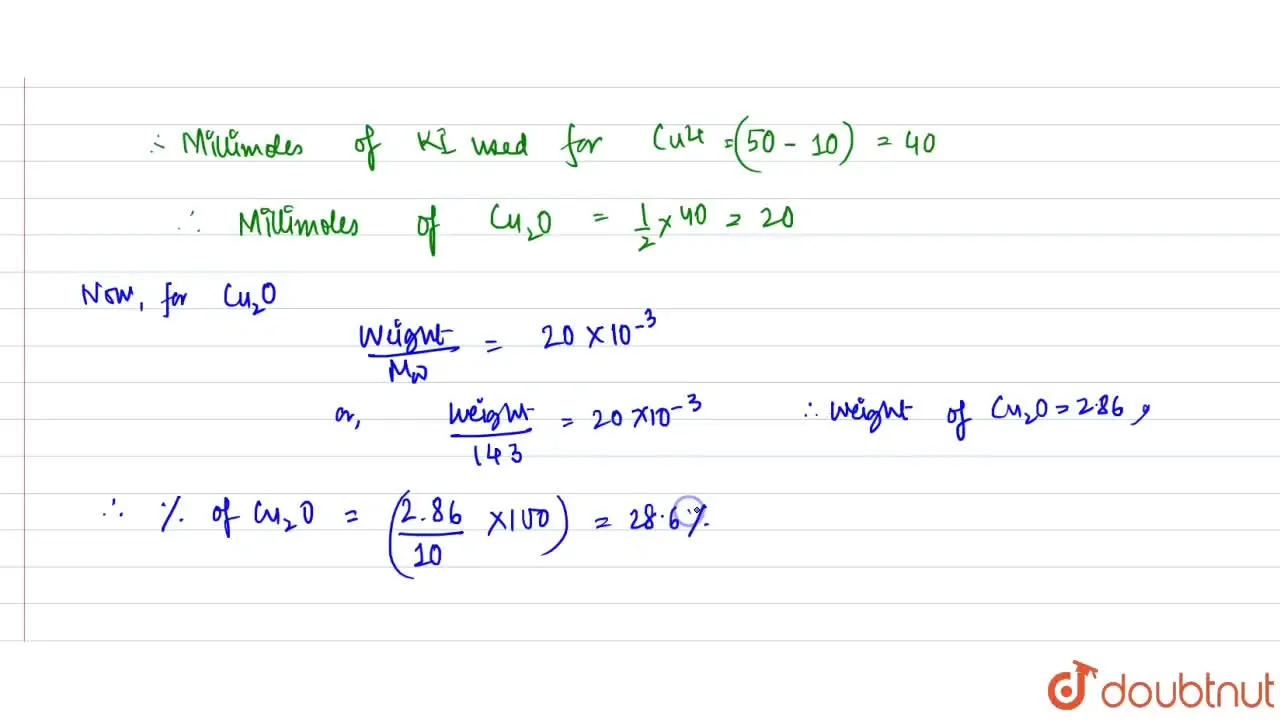10.0 g sample of Cu2O is dissolved in dil. H2SO4 where it undergoes disproportionation quantitatively. The solution is filtered off and 8.3 g pure KI cyrstals are added to clear filtrate in order to precipitate CuI with the liberation of I2. The solution is again filtered and boiled till all the I2 is removed. Now excess of an oxidising agent is added to the filtrate which liberates I2 again. The liberated I2 now requires 10 mL of 0.1M Na2S2O3.The percentage by mass of Cu2O in the sample is
Cu2O→Cu2++Cu0
The solution after dissolution of Cu2O in dil H2SO4 contains Cu2+ ions and Cu. Cu2+ ions react with KI to give CuI2 which is converted to CuI (or CU2I2) and I2.
Cu2++2Iɵ→CuI2→(Cu2I2orCuI)+12I2
Millimoles of KI taken=8.3166×103=50(mEofKI=166)
Now, KI left unused reacts with oxidising agent to liberate I2 again.
2Iɵoxidising agent−−−−−−−−→I22S2O2−3−−−−→S4O2−6+Iɵ
Millimoles of KI left= millimoles of S2O2−3 used
(n=22=1)=(n=22=1)
=10×1.0×1 (n factor)=10
Therefore, millimoes of KI used for Cu2+=50−10=40
Therefore, milli moles of Cu2O=20
C+1u2→2+2Cumolratioof+1Cu2:+2Cu=1:2
WeightMw×103=20 (Mw of Cu2O=143)
weight143×103=20
∴WCu2O=2.86
%ofCu2O=2.86×10010.0=28.6%
Related Playlists
- BOOK - CENGAGE CHEMISTRY ENGLISHCHAPTER - STOICHIOMETRYEXERCISE - Exercises Linked Comprehension42videos
STOICHIOMETRY
- BOOK - CENGAGE CHEMISTRY ENGLISHCHAPTER - STOICHIOMETRYEXERCISE - Exercises Multiple Correct30videos
STOICHIOMETRY
- BOOK - CENGAGE CHEMISTRY ENGLISHCHAPTER - STOICHIOMETRYEXERCISE - Ex 3.75videos
STOICHIOMETRY
- BOOK - CENGAGE CHEMISTRY ENGLISHCHAPTER - STATES OF MATTEREXERCISE - Exercises (Ture False)25videos
STATES OF MATTER
- BOOK - CENGAGE CHEMISTRY ENGLISHCHAPTER - THERMODYNAMICSEXERCISE - Archives (Subjective)23videos
THERMODYNAMICS
Similar Questions
638.0 g of CuSO4 solution is titrated with excess of 0.2 M KI solution. The liberated I2 required 400 " mL of " 1.0 M Na2S2O3 for complete reaction. The percentage purity of CuSO4 in the sample is
View Solution5g of a sample of bleaching powder is treated with excess acetic acid and KI solution. The liberated I2 required 50 mL of N10 hypo. The % of available chlorine in the sample.
View SolutionA 0.276 g impure sample of copper ore is dissolved and Cu2+ is titrated with KI solution. I2 liberated required 40 mL of 0.1 M Na2 S2 O3 solution for titration. What is the % of impurities in the ore ?
View SolutionA sample of Na2CO3.H2O weighing 0.62 g is added to 10 ml of 0.1NH2SO4 solution . The resulting solution will be
View SolutionExcess of Kl and dil. H2SO4 were mixed in 50 mL H2O2. The liberated l2 required 20 mL 0.1 N Na2S2O3. Find out the strength of H2O2 in g litre−1.
View Solution50.0 g sample of brass is dissolved in 1 L dil H2SO4.20mL of this solution is mixed with KI, and the liberated I2 required 20 " mL of " 0.5 M hypo solution for titration calculate the amount of Cu in the alloy.
View Solution50 ml of given H2O2 solution is added to excess KI solution in acidic medium. The liberated I2 required 20 ml of 0.04 M standard Hypo solution.
Molarity of H2O2 solution isView Solution10.0 g of CaOCl2 is dissolved in water to make 200 mL solution 20 " mL of " it is acidified with acetic acid and treated with KI solution the I2 liberated required 40 " mL of " M20Na2S2O3 solution. Find the percentage of available chlorine.
View SolutionA 0.5 g sample containing MnO2 is treated with HCl liberating Cl2 is passed into a solution of KI and 30.0 " mL of " 0.1 M Na2S2O3 are required to titrate the liberated iodine. Calculate the percentage of MnO2 is the sample.
View Solution0.10 g of a sample containing CuCO3 and some inert impurity was dissolved in dilute sulphuric acid and volume made up to 520 mL. This solution was added into 50mL of 0.04 M KI solution where copper precipitates as Cul and I− is oxidized into I−3. A 10 mL portion of this solution is taken for analysis, filtered and made up free I−3 and then treated with excess of acidic permanganate solution. Liberated iodine required 20 mL of 2.5 mM sodium thiosulphate solution to reach the end point.
Determine mass percentage of CuCO3 in the original sample.View Solution


